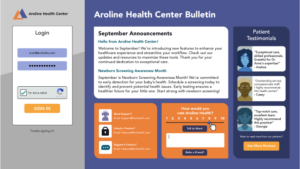Hoping to improve patient experiences and apply a patient-centric marketing approach? Understanding the patient journey is crucial to achieving your goals. Patient journey mapping is a powerful tool that ultimately enables healthcare professionals to increase patient acquisition and retention.
What is Patient Journey Mapping?
Patient journey mapping is a process that visually outlines the patient’s path from the initial awareness of a problem through choosing treatment providers and receiving healthcare, all the way to post-treatment.
This process helps you analyze the patient’s experience across various touch points within the healthcare system. Considering every interaction a patient has with a healthcare professional offers valuable insight for building a full-funnel marketing strategy.
Following these touchpoints, healthcare organizations can create more engaging marketing strategies, identify potential improvements, and create a more patient-centric approach to care.
Why is Patient Journey Mapping Important?
Patient journey mapping can enhance various aspects of your healthcare business, from marketing strategies to operational efficiency. By carefully mapping each stage of the patient journey, healthcare organizations can gain valuable insights that lead to better patient acquisition, retention, and satisfaction.
Boosting Patient Acquisition
Understanding the initial stages of the patient journey provides the opportunity to tailor your marketing efforts to attract new patients more effectively. Targeted marketing strategies based on patient personas and patient journey insights lead to higher conversion rates and attract the right patients to your practice.
Improving Patient Retention
A well-mapped patient journey identifies key touchpoints where patients may disengage. By addressing these pain points, you can foster stronger relationships with your patients, encouraging them to return for future care.
Enhancing Patient Experience
A thorough understanding of the patient journey also allows you to identify and address pain points that could negatively impact the patient’s experience. By streamlining processes and enhancing interactions at each stage, you can create a more friendly and satisfying experience for your patients.
Streamlining Internal Processes
Mapping the patient journey helps identify inefficiencies in your processes, from scheduling to follow-up care. Optimizing these processes can reduce wait times, improve staff coordination, and enhance overall operational efficiency.
Increasing Cost Effectiveness
 By identifying and addressing inefficiencies and pain points, you can reduce unnecessary costs. Whether it’s through better resource allocation or more targeted marketing efforts, a well-mapped patient journey can lead to significant cost savings.
By identifying and addressing inefficiencies and pain points, you can reduce unnecessary costs. Whether it’s through better resource allocation or more targeted marketing efforts, a well-mapped patient journey can lead to significant cost savings.
Building Strategic Marketing
Patient journey mapping provides invaluable insights into patient behavior and preferences, allowing healthcare professionals to develop more effective and targeted marketing campaigns. This strategic approach can lead to higher engagement, better patient outcomes, and a stronger return on investment (ROI) for marketing efforts.
Steps to Effective Patient Journey Mapping
Now that we’ve reviewed the benefits of patient journey mapping, let’s dive into the how-to. This comprehensive guide includes all the critical steps to creating an effective visualization.
You can use a whiteboard, pen and paper, spreadsheet, or a mind map, or you can find and download a patient journey map template online. No matter which initial method you choose, we recommend creating a final digital file to share with your staff, marketing team, and shareholders.
Step #1: Define Your Goals and The Scope
First things first: you must define your business goals and the scope of the project.
Are you looking at the entire patient journey or are you focusing on specific aspects, like the new patient experiences, patients with chronic conditions, or even a particular service line?
Remember, the journey a patient takes for a routine flu shot is vastly different from the journey of a patient who needs knee surgery, and your approach should reflect these differences.
What are you hoping to accomplish with this map? Is your goal to increase patient acquisition, reduce wait times, enhance patient communication, or streamline post-care follow-up? Or perhaps you’re looking to tailor your marketing strategies more effectively across different service lines.
Whatever your goals, having them clearly defined from the beginning will help guide your mapping process and ensure that the final product is both focused and actionable.
To start, think about all the questions we just asked. Drive your goals home and make sure they’re attainable and measurable by following the SMART goals matrix.
Step #2: Collect and Analyze Your Data
Once you’ve defined your goals and the scope of your project, it’s time to gather and analyze the data that’ll inform your patient journey mapping. This is where you’ll uncover the insights that will shape your understanding of the patient experience, helping you fine-tune your marketing strategies.
Here are some data points you’ll want to collect to get a comprehensive view:
Patient Surveys and Interviews: Direct feedback from patients is gold. It gives you a clear picture of their experiences, expectations, and frustrations. This data can highlight specific areas where the patient experience can be improved, and where your marketing efforts might need to be more targeted.
Healthcare and Marketing Analytics: Dive into your electronic health records (EHR), patient management systems, and marketing analytics tools. Identify patterns in patient behavior, trends in appointment scheduling, and the effectiveness of your marketing campaigns. This will help you understand how patients are interacting with your services and how your marketing efforts are influencing their journey.
 Staff Feedback: Don’t overlook your healthcare staff—they’re on the front lines interacting with patients every day. Their insights can uncover pain points and areas for improvement that might not be immediately obvious through patient feedback alone. Plus, they can provide context for certain trends or patterns you might see in the data.
Staff Feedback: Don’t overlook your healthcare staff—they’re on the front lines interacting with patients every day. Their insights can uncover pain points and areas for improvement that might not be immediately obvious through patient feedback alone. Plus, they can provide context for certain trends or patterns you might see in the data.
Step #3: Identify Key Patient Personas
Now that you’ve collected and analyzed your data, it’s time to put it to work by identifying key patient personas. Commonly known as buyer personas or customer archetypes, these personas are fictional yet data-driven characters that represent the different types of patients who interact with your healthcare organization. Patient personas guide you in crafting messages, strategies, and experiences that resonate with real people.
Patient personas should be grounded in the data you’ve collected, reflecting the diverse needs, preferences, and behaviors of your patient base. For example, you might create a persona for a young, tech-savvy person who’s all about convenience and is likely searching for routine check-ups online. Or you could develop a persona for an older patient managing a chronic illness, who may prioritize accessibility and personal interaction over digital convenience. Additionally, different service lines could yield different personas, and any personality trait can help you further dive into their reasoning and preferences.
But what if you’re short on data? Don’t worry—start with what you have. Even basic demographic and behavioral information can help you sketch out initial personas. As you continue to collect more data over time, these personas can and should evolve. Personas are not a one-and-done project; they’re a living, breathing part of your marketing strategy that’s constantly refined as you learn more about your patients.
Well-built patient personas will allow you to segment your audience more effectively, tailor your marketing campaigns to specific groups, and ensure that your patient journey map reflects the different experiences of your patient mix. This approach will lead to more targeted, effective marketing strategies and a personalized patient experience at every touchpoint.
Step #4: Map Out the Patient Journey Stages
With your data in hand and your patient personas clearly defined, it’s time to map out the patient journey. This is where all the pieces come together, allowing you to see how your patients move through each stage of their healthcare experience—and how your marketing efforts can guide them along the way.
Start by breaking down the journey into key stages, each representing a different phase of the patient experience:
Awareness Stage
This is where it all begins. At this stage, the patient notices symptoms and starts contemplating—whether it’s something as simple as a sore throat or as complex as considering surgery. Your marketing efforts here should focus on capturing attention and building awareness of your services through informative content, actionable advice, and community outreach.
Consideration Stage
Once a patient is aware of their need, they move into the consideration stage. This is where they start researching and evaluating different healthcare professionals. They’re looking at your website, reading reviews, and comparing options. It’s crucial to have strong, persuasive content that highlights what sets your practice apart, like patient testimonials, service highlights, and clear procedure guidelines that set patients’ expectations.
Decision Stage
After weighing their options, the patient chooses a healthcare professional and takes action—whether that’s booking an appointment online, calling your office, or walking in. At this stage, your focus should be on making the decision-making process as seamless and stress-free as possible. Streamline your appointment scheduling process, provide clear instructions, and ensure communication is welcoming and supportive.
Appointment and Treatment
Finally, the patient attends the appointment and receives treatment. This is the core of their journey, where all their previous interactions culminate. It’s essential that the experience here lives up to—or exceeds—the expectations set during the earlier stages. From the reception they receive to the quality of care, everything should reinforce their decision to choose your practice.
Post-Treatment Follow-up
Wait! The journey doesn’t end when the patient walks out the door. Follow-up care is essential, not just for their health, but for building long-term loyalty. Whether it’s scheduling a follow-up appointment, providing post-treatment instructions, or sending a simple message to check in and ask if they’re recovering well, these touchpoints keep the relationship alive and open the door for future interactions.
Mapping out these stages in detail will give you a clear and actionable overview of the entire patient journey, helping you identify where your marketing efforts can make the most impact and guide patients through the pipeline.
Step #5: Analyze and Predict Patient Behaviors
As you map out the patient journey, it’s crucial to dive deeper into understanding and predicting patient behaviors at each stage. While data is the most valuable part of achieving this, it also helps to put yourself in your patients’ shoes and consider what they’re thinking about and how they make these important decisions. This can help you fine-tune your approach and ensure your touchpoints align perfectly with your patients’ needs and expectations.
What is the patient thinking? At each stage of the journey, consider the thoughts running through the patient’s mind. Are they worried about finding the right doctor? Are they concerned about the cost of treatment? Understanding their concerns and motivations will help you create relatable messaging, whether it’s reassurance through patient testimonials or clear information about insurance coverage.
What is the patient doing? Then, think about the actions the patient is likely taking. Are they researching symptoms online? Comparing healthcare options? Talking to friends or family? Understanding what actions the patient may take allows you to position your brand where it matters most—be it optimizing your website for search, responding on review sites, or running targeted ads.
 How can patients interact with your brand at this stage? It’s not just about being present—it’s about being accessible. Identify the touchpoints where patients can engage with your brand. Are they likely to visit your website, call your office, or interact with your social media? Make sure these channels are easy to find, user-friendly, responsive, and provide the information or support they’re seeking.
How can patients interact with your brand at this stage? It’s not just about being present—it’s about being accessible. Identify the touchpoints where patients can engage with your brand. Are they likely to visit your website, call your office, or interact with your social media? Make sure these channels are easy to find, user-friendly, responsive, and provide the information or support they’re seeking.
What are the key touchpoints? Throughout the patient journey, there will be critical touchpoints where your brand can make a lasting impression. These might include your website’s contact form, a consultation booking system, the first phone call, or the check-in process at your office. Analyze how these touchpoints are currently performing and look for opportunities to improve them—whether through better technology, improved communication, or more personalized service.
By carefully analyzing and predicting patient behaviors, you can ensure that your marketing and patient engagement strategies are perfectly aligned with what your patients need at every stage of their journey.
You’ve Got The Patient Journey Map, Use It!
Now that you’ve mapped out the patient journey, analyzed patient behaviors, and identified key touchpoints, it’s time to put this valuable information to work.
The final step is to use your patient journey map to inform both your marketing strategies and your approach to patient-centric care. Ensure that every interaction your patients have with your brand is as effective and meaningful as possible.
Tailor Your Marketing Strategies
With a clear understanding of each stage in the patient journey, you can craft marketing strategies that speak directly to your patients’ needs, concerns, and preferences.
For example, if you know that potential patients are heavily researching online during the consideration stage, invest in high-quality content that answers their questions and showcases your expertise. Use predictive targeting, social media campaigns, and SEO strategies to ensure your brand is visible when and where it matters most.
By aligning your marketing efforts with the specific phases of the patient journey, you can attract more qualified leads, increase conversions, and build stronger relationships from the start.
Enhance Patient-Centric Care
The insights gained from your patient journey mapping also play a crucial role in delivering patient-centric care. By understanding what patients are thinking and doing at each stage, you can anticipate their needs and provide a more personalized, emphatic experience.
For example, if patients are anxious before a certain procedure, proactive communication with clear instructions and a reassuring tone can make all the difference. Use your map to identify opportunities for personalization—whether it’s sending a follow-up message tailored to their specific treatment or offering resources that address their unique health concerns.
Create Positive Experiences
One of the most significant benefits of using a patient journey map is its versatility and ability to create consistent, positive experiences across all stages of the funnel. Whether a patient is visiting your website, talking to your staff on the phone, or sitting in your waiting room, their experience should be seamless and aligned with their expectations.
Consistency builds trust, and trust leads to long-term loyalty and improves patient retention. By using the journey map to train your team, refine your processes, and guide your communications, you ensure that your patients feel valued and cared for every step of the way.
 Track and Optimize
Track and Optimize
Finally, remember that the patient journey is not static. Continuously monitor the effectiveness of your marketing strategies and patient care practices. Use patient feedback and marketing data to refine your patient journey map and make necessary adjustments. The ongoing process of measuring and optimizing will help you stay responsive to patient needs, adapt to changes in the healthcare industry, and maintain a competitive edge.
Help Yourself With Healthcare Marketing Technology
Mapping the patient journey is a powerful way to grow your healthcare business. By integrating your patient journey map into both your marketing and care strategies, you create a comprehensive, patient-centered approach that effectively attracts and retains patients and fosters a deeper connection with them.
This approach ensures that every aspect of your practice—from the first touchpoint to post-treatment follow-up—is designed to create better outcomes for both your patients and your healthcare organization.
By understanding the nuances of each stage, you can deliver more personalized patient experiences that build long-term loyalty. However, achieving this level of insight and precision requires the right tools.
This is where healthcare marketing technology comes in. With robust, HIPAA-compliant marketing data, unique predictive targeting features, and automated patient surveys, SocialClimb’s comprehensive healthcare marketing platform empowers you to seamlessly integrate data-driven strategies into your patient journey mapping.
If you’re looking to improve patient acquisition and retention while optimizing your marketing budget, SocialClimb provides the tools you need to make informed decisions and drive high ROI, ensuring the scalable growth of your healthcare organization.











